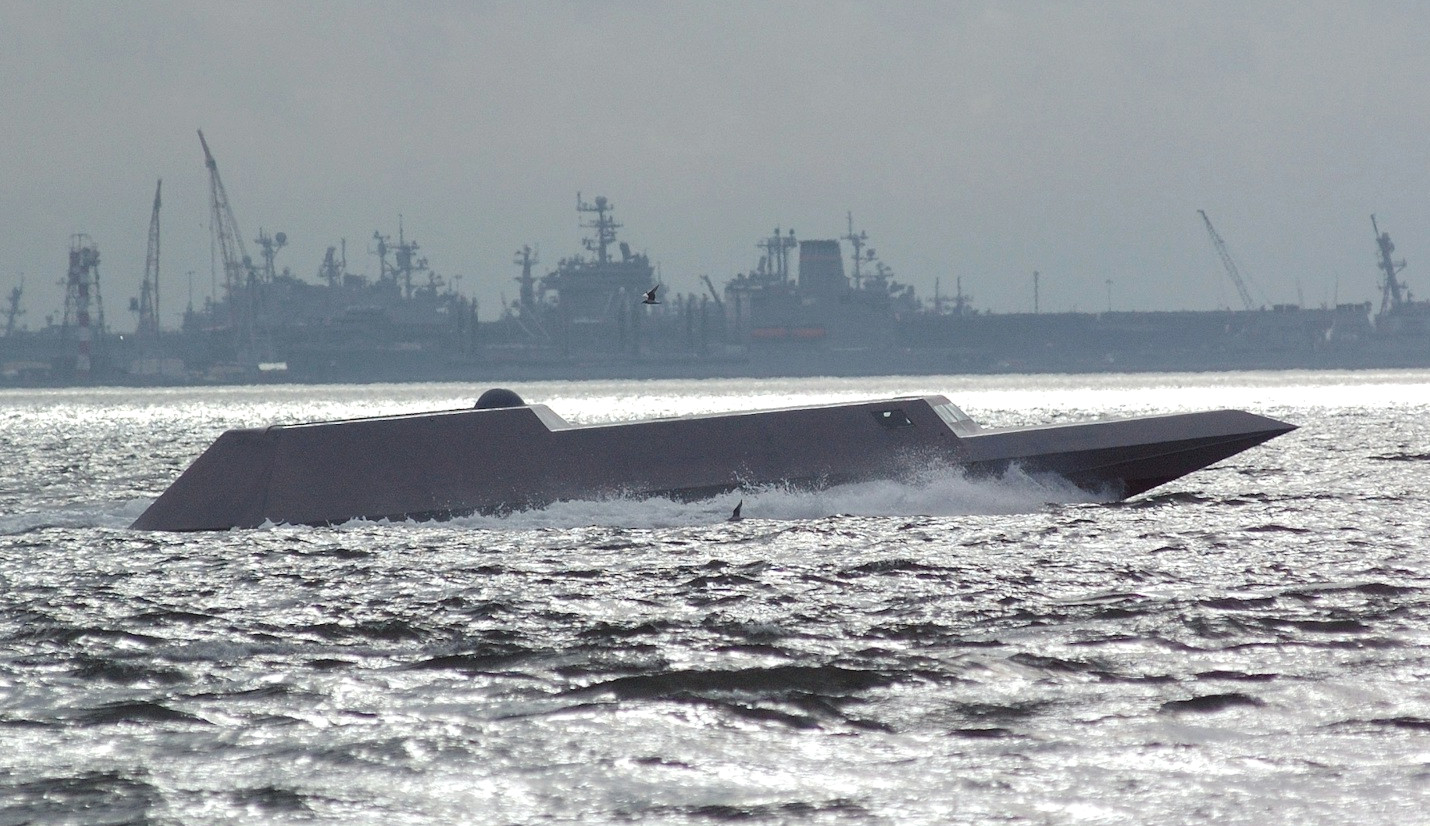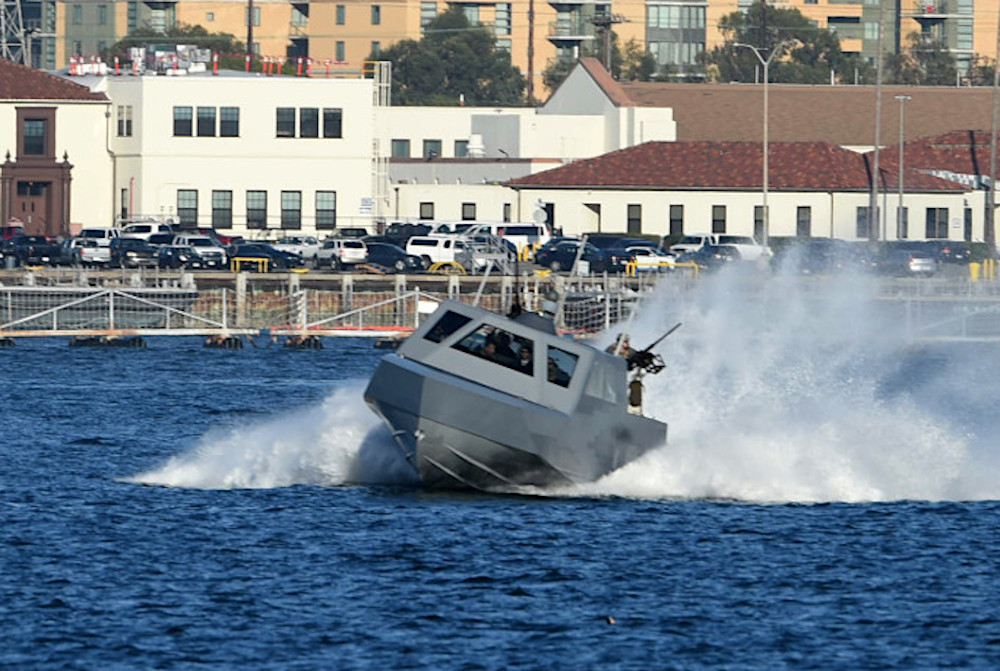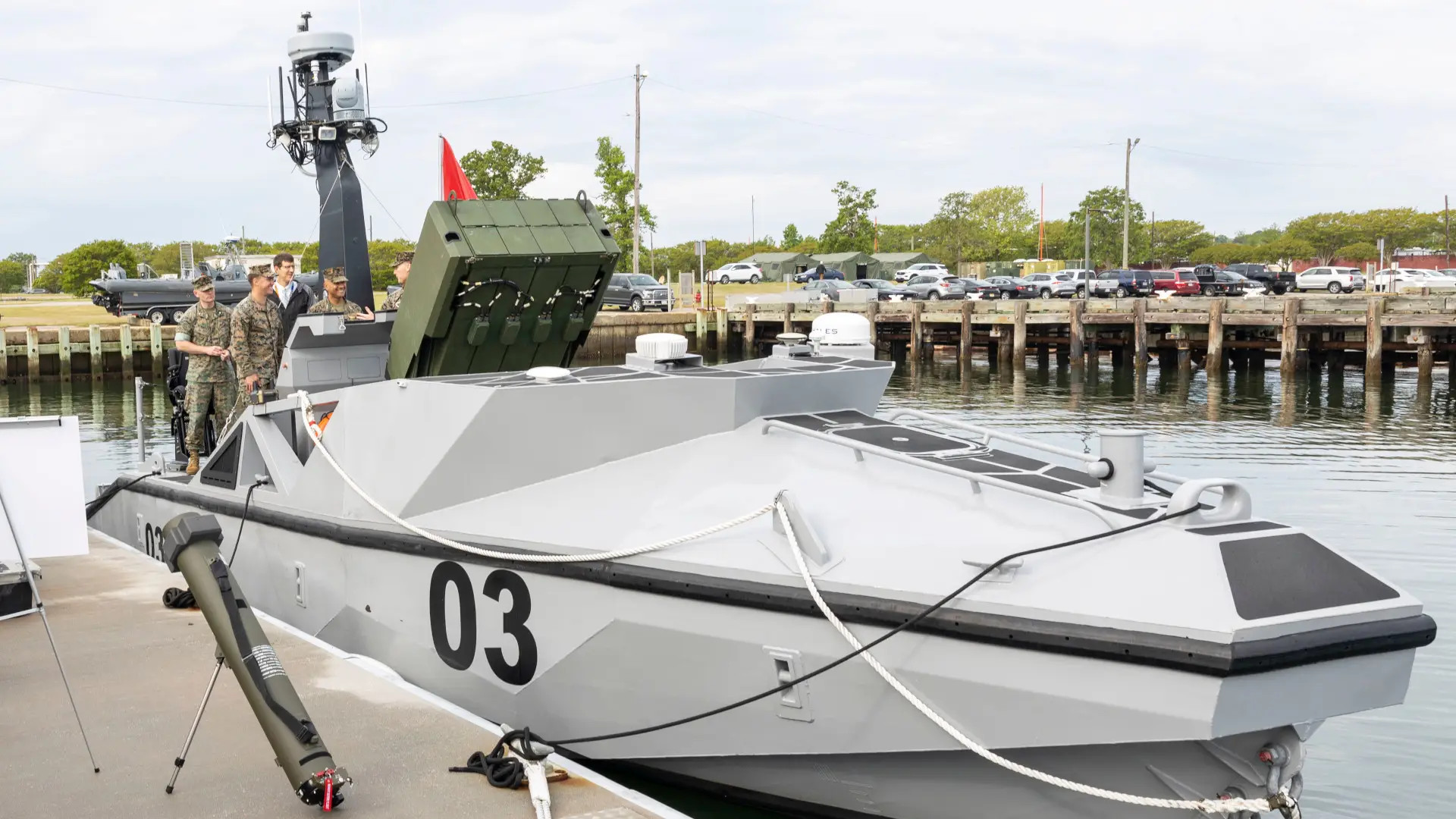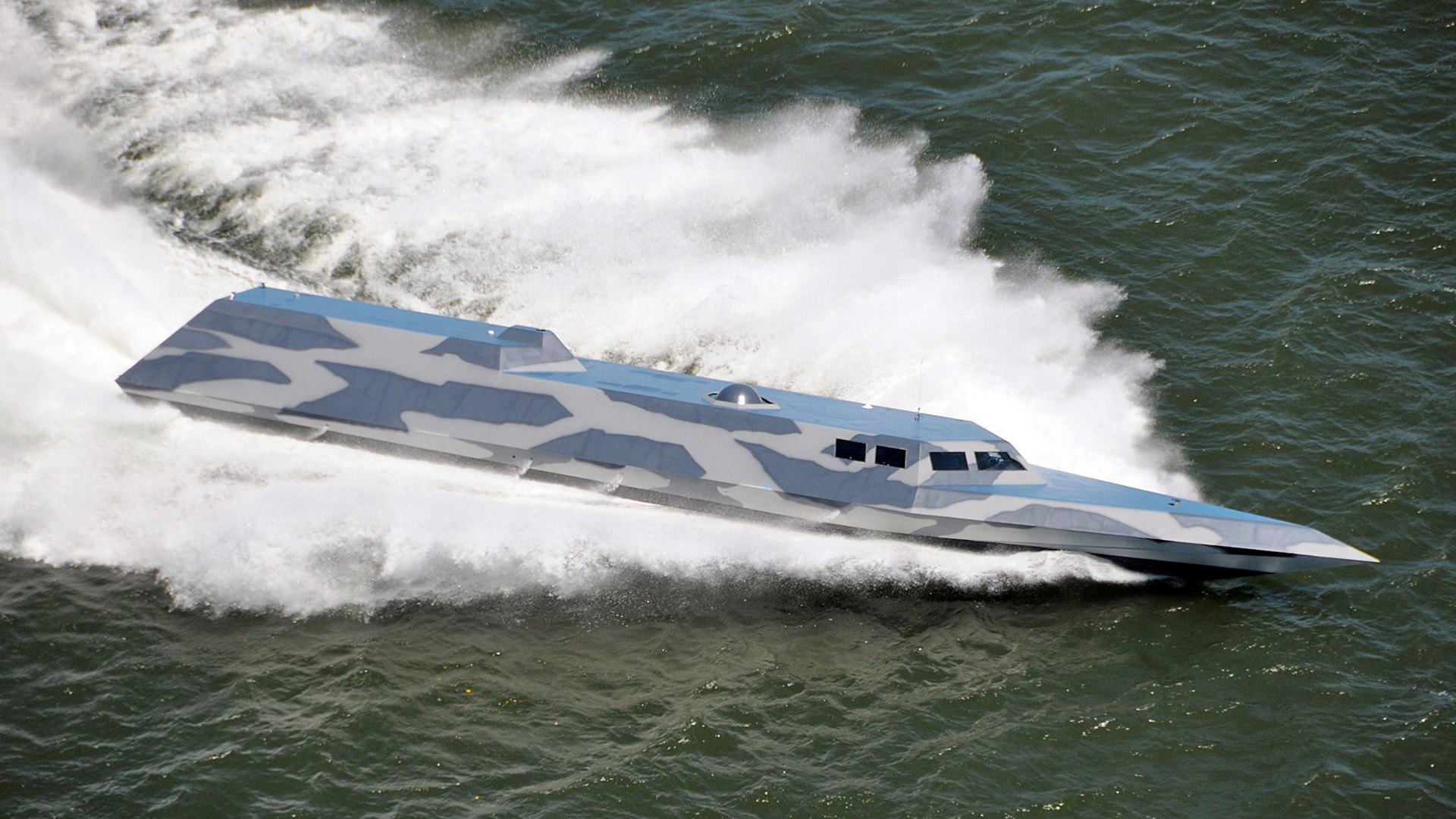The U.S. Navy just recently awarded a contract for the production of the fourth Combatant Craft Heavy (CCH). This is part of a larger plan to modernize the fleet of CCHs, also known as Sealions, which are the biggest and most secretive of the service’s three tiers of stealthy special operations boats. Testing is also now underway on a pop-up eight-round loitering munition launcher for the middle-weight Combatant Craft Mediums (CCM).
Navy Cdr. Marty Burns, the program manager for surface systems within U.S. Special Operations Command’s (SOCOM) larger Program Executive Office for Maritime systems (PEO-M), provided details about the CCH fleet and the loitering munition launcher for the CCM to The War Zone and other attendees at the annual SOF Week conference on Tuesday. Beyond the CCH and CCM, the current U.S. special operations boat fleets include the Combatant Craft Assault (CCA), the smallest of the stealthy types, and the non-stealthy Special Operations Riverine Craft (SOCR). The Navy has other patrol and riverine-style combat boats in service outside of the Naval Special Warfare community, though the size of those fleets has been shrinking in recent years.

“We just put [CCH] number four on contract” in “late April to Fincantieri,” Burns said. Under that contract, “they have an option for craft five,” as well.
The current plan for the CCH program is to “drop the first one and two off, and keep three, four and five,” Burns added, but did not elaborate on the expected timeline to achieve this end state. His briefing also included an image, seen below, of a CCH version with a distinctly different front window arrangement from what has been seen on these boats in the past. However, it is not immediately clear if this shows the current configuration of one of the existing three examples or is a rendering of the expected look of the fourth hull.

Oregon Iron Works, a boutique shipbuilder in Portland, Oregon that subsequently evolved into a division of what is now called Vigor Industrial, designed and built the first three CCHs. It is unclear whether or not Vigor is involved in any way in the construction of the fourth CCH, but the company has partnered with Fincantieri in the past, and The War Zone reached out for more information. SOCOM has previously said that CCH number four will incorporate lessons learned from the production of the third one of these vessels, which was delivered sometime in 2021. The third CCH was actually the first to be built from the start to the Navy’s specifications.
The two original CCHs “were technology demonstrators … transferred over or modified with MFP-11 dollars,” Cdr. Burns explained yesterday. “So, 20-some years old, I think, the first one is, and then the next one is in the 15-16 2025 range.”

MFP-11 (Major Force Program 11) is a SOCOM-specific funding stream that traces its roots back to the origins of the command in the late 1980s.
The origins of the CCH program trace back to the 1990s with a predecessor design from Oregon Iron Works known as the Alligator or Alligator class. The U.S. special operations community is understood to have tested the Alligator before passing it along to the Israel Defense Forces. Oregon Iron Works may also have contributed to the design of a similar special operations watercraft in service with the Singaporean Navy.
Whatever the case, the U.S. military subsequently acquired the two CCH demonstrators as part of what was originally known as the Sea, Air, Land Insertion, Observation, and Neutralization (SEALION) program.
The first three CCHs have also been referred to as SEALION-I, SEALION-II, and SEALION-III in the past. They all have slightly different designs though their capabilities are understood to be very similar. The initial two examples are readily distinguishable by the number of windows they have on the sides of the front end of their hulls – the first one has only a single window on each side, while the second has a pair on both sides.

“This… right here is our premier kind of like a medium-range to long-range… high survivability craft to conduct operations,” Cdr. Burns said of the CCHs on Tuesday. The boats have a stealth upper super structure and a very low profile in the water that further helps reduce their radar and visual signitures.
Details about the CCHs and their capabilities have historically been limited, even compared to the other stealthy special operation boats known to be in the Navy’s inventory. We have no idea where and when the CCHs have been used and the missions they clearly have been involved in look to be deeply classified.
“The CCH is a fully enclosed, climate-controlled, semi-submersible craft that operates in contested environments,” according to the Pentagons’ 2025 Fiscal Year budget request. “The CCH is NSW’s [Naval Special Warfare’s] most versatile and survivable combatant craft and the craft-of-choice for sensitive maritime intelligence, surveillance, and reconnaissance missions.”

“CCH capabilities” include a “40 kt speed; 7 crew + 12 pax/3,300 lb payload; and 400 nm range” and “the CCH payload capacity enables [the] inclusion of shock mitigating seat for the piloting teams, which is critical for ride quality, operator tactical readiness, and operator health,” the budget documents note. “At 77+ feet long, the CCH is C-17/C-5 transportable and can launch/recover by a gray hull well deck or shore-based mobile travel lift or crane.”
“Gray hull” here refers to military-owned and operated ships rather than contracted vessels, which the U.S. special operations community also uses operationally, including to support small boat operations. The CCHs are also known to have retractable masts with sensors and communications antennas, as well as the ability to launch and recover jet skis and inflatable rubber raiding craft, as well as individual combat divers via a large rear hatch.

The idea of adding loitering munitions to SOCOM combatant craft fleets is much newer than the CCH program, but is still something the command has been looking at for years now. What is formally known as the Maritime Precision Engagement (MPE) effort dates back to at least 2018.
“Maritime precision engagement, as you can see, this is a stand-off, loitering… man-in-the-loop, guided munition,” Cdr. Burns said on Tuesday. “So where are we at with this? Currently, we’re integrating [the system] within a CCM, an operational craft, CCM 11.”

“So we should be finalized with all testing, live-fire to be included, by the end of FY [Fiscal Year] 24, early [FY] 25,” according to Burns. After that, SOCOM plans to make a decision about integrating the system on additional CCMs.
Details about the MPE system, as it exists now, are limited. However, Burns’ presentation earlier this week included a slide showing a pop-up eight-round launcher that looks like it can retract flush in a section of the CCM’s hull, as seen below. This would make sense in order to help maintain the overall stealthy characteristics of the vessel while retaining open deck space.

The launcher being tested on the CCM looks similar to one capable of firing Uvision Hero-120 loitering munitions that the U.S. Marine Corps has been testing integrated onto variants of its 8×8 Light Armored Vehicle (LAV) family and its new Long Range Unmanned Surface Vessel (LRUSV) drone boats. The U.S. special operations community, via the Pentagon’s Irregular Warfare Technical Support Directorate (IWTSD), has been at least testing a variant of the Hero-120 designed to be fired from a man-portable launch tube on the ground since 2021.

Uvision’s website currently lists the baseline Hero-120 as having a maximum range of at least 37 miles (60 kilometers), a maximum endurance of 60 minutes, and a roughly 10-pound (4.5 kilogram) warhead. The Hero-120, like many modern loitering munitions, also known as kamikaze drones, has a limited secondary surveillance and reconnaissance capability thanks to its electro-optical and infrared cameras and operator-in-the-loop control system.
As The War Zone has written in the past when discussing this particular loitering munition:
“This control concept, partially pioneered by Israeli companies along with the very idea of loitering munitions, allows a human user to ‘see’ what the munition does throughout the entire flight and make fine course adjustments. This helps with positive target identification and improves accuracy. It also provides the option of ‘waving off’ the munition even very late in the terminal phase of an attack, if necessary, such as due to the sudden appearance of innocent bystanders in the area.”

It is also possible that the launcher is for another type of loitering munition. Previous SOCOM briefing slides about MPE have shown the smaller Hero-30 as an example of a relevant design. Last October, the Navy also conducted a test involving a MARTAC Devil Ray T38 uncrewed surface vessel equipped with a launcher for AeroVironment Switchblade 300 loitering munitions.
Cdr. Burns’ MPE program slide, seen below, also included a graphic depicting a CCM launching a loitering munition and handing over control to an operator on the ground ashore. This could help extend the reach and flexibility of whatever type of loitering munition is now being added to the CCM.

SOCOM’s work to modernize the CCH fleet and add new stand-off munitions to the CCMs in many ways reflects a broader shift in focus within the U.S. special operations community from decades of counter-terrorism operations to being better prepared to contribute to future major conflicts. These new maritime capabilities could be especially relevant in a potential high-end fight in the Pacific against China, though they could easily be used in many other regions around the world.
Regardless, there are important changes on the horizon for the Navy’s secretive CCH fleet and middle-tier CCMs could soon be wielding kamikaze drones launched from new pop-up launchers.
Contact the author: joe@twz.com
